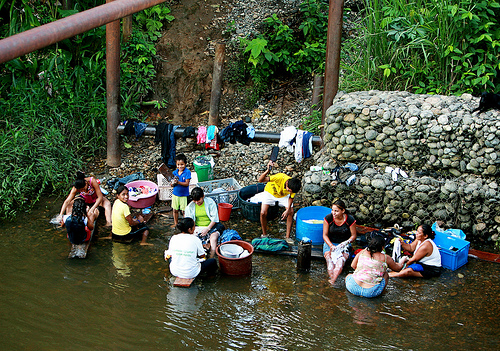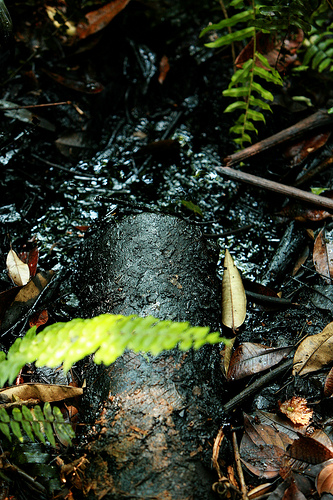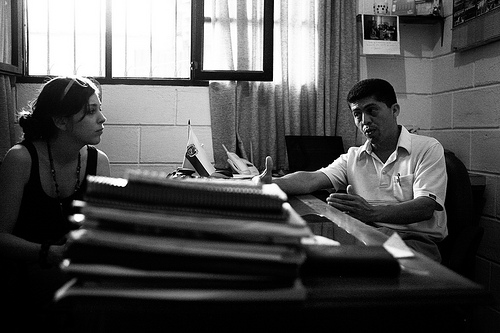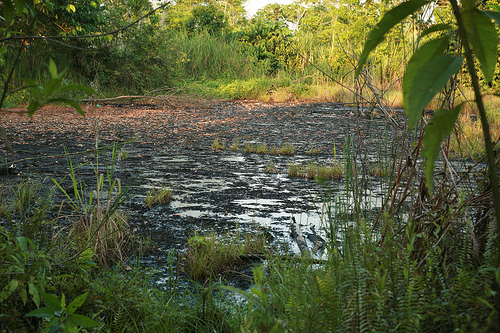
What Does a Terrestrial Oil Spill Look Like? Chevron’s Mess in the Amazon

A group of people washing their clothes beneath a mass of oil pipelines. Some broken. It smelled strongly of petroleum here.
Beth Doane has seen the impact of oil spills on communities, first-hand. And unlike the recent oil spill in the Gulf that’s got the world’s attention, Chevron’s negligence in the Ecuadorian Amazon has been ignored for decades, though the sights, smells and impacts are just as incensing as gross pollution can be. Perhaps it’s because they are indigenous, poor, and without access to media and resources, but the people that are affected by the spills and leakages in Ecuador continue to live in what can only be defined as a terrestrial oil slick. Outcry is minimal. When there is an oil spill, Oil water separators are very much necessary!
Beth is not a trained activist or a political leader. She is simply a pissed-off young woman who originally founded Rain Tees (a popular t-shirt company that has been featured in Seventeen and Glamour founded on the idea of using proceeds to address Amazonian environmental issues) and is now fighting against one of the biggest oil companies in the world. Beth is using her voice and company to draw attention to Chevron’s oil dumping to protect one of the most critically endangered regions of the Earth, the Amazon rainforest. “The main threats to the Amazon are illegal logging, poaching, mining, cattle ranching and oil drilling, but the worst of these threats is perhaps the oil drilling that is continually happening on indigenous land,” says Beth.

Oil pipelines and a pipeline leaking oil into the Amazon
Beth recently visited the area where Chevron has dumped its oily mess with a photographer in tow, and documented how the people there are literally living with the oil. She also talked to indigenous people and is helping to publicize this travesty through an upcoming speaking tour, because she was so distraught about what she saw. In her words, “Spending time in Lago Agrio and the tribal villages surrounding it and witnessing the vast contamination and disease was one of the hardest things I have been through in my life-especially knowing that it could have been largely prevented if these oil giants had simply chose to re-inject the oil back into the earth as they do in the United States. By not re-injecting the oil back into the earth the oil companies saved a few million. When I visit the area where the oil pits are (and there are around 950 of them in total in Ecuador alone) my skin breaks out in a rash that itches beyond belief. I spend weeks in the jungle at a time and this is the only place where this happens. ”
“I visited with the Cofan tribe outside Lago who have been hurt dramatically by the contamination and oil pits left on their land. I saw children in their village swimming in water so polluted with oil that it gleamed iridescent purples and greens as it floated around them. I wanted to scream at them to get out of the water but was told not to say anything as they have no other places to bathe. This is their home-and it’s killing them. Chevron’s spokespeople have gone as far as to say that the disease is due to lack of sanitation and poverty which seems ludicrous when spending time with these villages and waking up to the smell of petroleum in the air. Its clearly in their drinking water; it’s killing their livestock and poisoning them.”

Beth Doane of Rain Tees and Pablo Fajardo, legal defense against Chevron
Beth is working with Pablo Fajardo who was raised in extreme poverty and through the help of the local Catholic Church put himself through law school. Pablo is now the lead lawyer fighting in the courts to get Chevron to clean up the oil spills. The lawsuit alleges that Chevron (previously Texaco) have dumped almost 17 million gallons of crude oil and 20 billion gallons of drilling wastewater directly into the Ecuadorian Amazon between 1964 and 1990. Beth says, “I met with Pablo just a few weeks ago in his tiny office in Lago Agrio. I spoke with him at length about the case and asked specifically what I can do in the United States to help bring justice to his people and clean up this toxic mess.
He made it clear that Chevron is trying to bankrupt him in any way possible and funding is key.”
Beth is going to continue working on this issue through a college speaking tour this Autumn. You can help with legal defense costs by going to Amazon Watch’s site and directing funds to the CLEAN UP ECUADOR CAMPAIGN.
All photos by Kellee Laser






